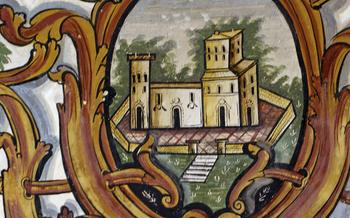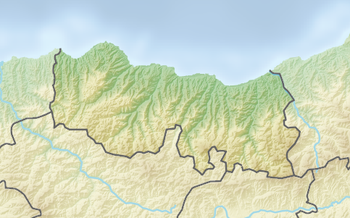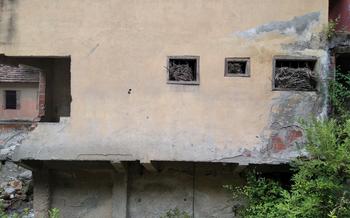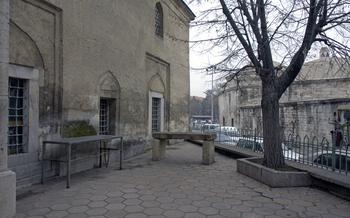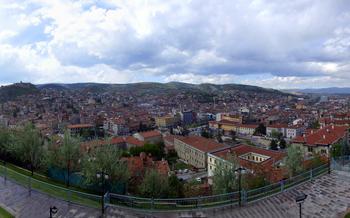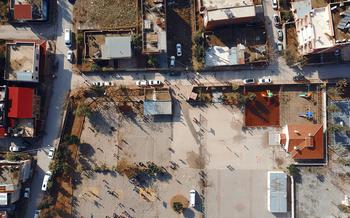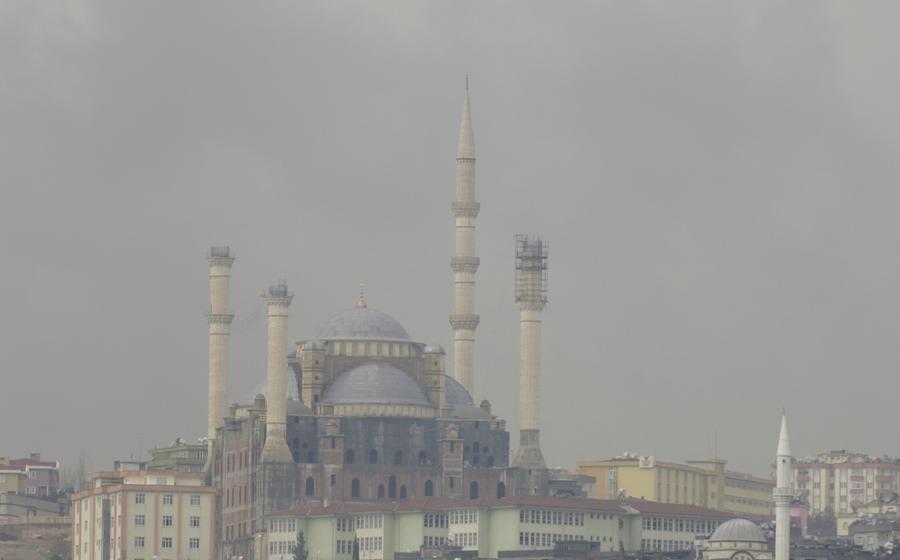
Abdulhamid Han Mosque
- Abdulhamid Han Mosque: A Stunning Masterpiece
- Historical Significance: A Symbol of Resilience
- Architectural Marvel: A Blend of Styles
- Interior Splendor: A Realm of Serenity
- Cultural Importance: A Gathering Place
- Prayer Experience: A Spiritual Journey
- Description of the Prayer Rituals and Customs
- The Mosque's Acoustics and Atmosphere During Prayers
- Personal Reflections on the Spirituality and Tranquility of the Experience
- Practical Tips for Visitors Wishing to Participate in Prayers
- Visiting Hours and Dress Code
- Location and Transportation
- Guided Tours and Accessibility
- Surrounding Attractions: Exploring Kahramanmaraş
- Photography and Social Media
- Local Customs and Traditions: A Tapestry of Respect
- Budget Tips: Exploring on a Shoestring
- Safety and Security: Ensuring a Hassle-Free Visit
- Insider Tip: Unveiling Hidden Gems
Abdulhamid Han Mosque: A Stunning Masterpiece
In the heart of Kahramanmaraş, nestled amidst bustling streets, stands the magnificent Abdulhamid Han Mosque, a testament to the city's rich history and architectural heritage. Built in the late 19th century during the reign of Sultan Abdul Hamid II, this iconic mosque has become a symbol of Turkish resilience, blending Ottoman, Seljuk, and Byzantine architectural styles into a breathtaking masterpiece.
The mosque's striking grandeur is evident from afar, with its towering dome and minarets piercing the skyline. Its intricate tilework, calligraphy, and decorative motifs create a captivating visual symphony, inviting visitors to step into a realm of serenity and spiritual wonder.
Beyond its architectural marvel, the Abdulhamid Han Mosque holds a profound significance for the local community. It serves as a center for religious and social gatherings, fostering a sense of unity and belonging among the people of Kahramanmaraş. Its role in preserving Turkish traditions and heritage makes it a cherished landmark, deeply woven into the city's cultural fabric.
Historical Significance: A Symbol of Resilience
The Abdulhamid Han Mosque holds immense historical significance as a symbol of Turkish resilience. Constructed during the reign of Sultan Abdul Hamid II, the mosque stands as a testament to the strength and perseverance of the Turkish people. Despite facing numerous challenges throughout its existence, including wars, natural disasters, and political upheavals, the mosque has remained steadfast, serving as a beacon of hope and resilience for generations.
One of the most notable events in the mosque's history is its survival during the Great Fire of Kahramanmaraş in 197The fire, which ravaged much of the city, miraculously spared the mosque, leaving it as one of the few remaining structures from that era. This event further cemented the mosque's status as a symbol of Turkish resilience, a reminder of the nation's ability to rise from adversity and rebuild.
Throughout history, the Abdulhamid Han Mosque has played a crucial role in fostering unity and community spirit among the people of Kahramanmaraş. It has served as a gathering place for religious celebrations, cultural events, and social initiatives, strengthening the bonds between community members. The mosque's endurance through challenging times has made it a symbol of the Turkish people's unwavering faith and determination.
Architectural Marvel: A Blend of Styles
The Abdulhamid Han Mosque stands as a testament to the architectural prowess of the Ottoman Empire. It seamlessly blends elements from various eras and cultures, creating a unique and harmonious masterpiece. The mosque's grand dome, reminiscent of Byzantine architecture, dominates the skyline and is a symbol of its grandeur. Its towering minarets, a signature feature of Islamic architecture, pierce the heavens, beckoning the faithful to prayer.
The mosque's exterior is adorned with intricate tilework and calligraphy, showcasing the artistry and craftsmanship of Ottoman artisans. Geometric patterns, floral motifs, and verses from the Quran dance across the walls, creating a mesmerizing visual symphony. The harmonious blend of blues, greens, and golds adds a touch of elegance and serenity to the mosque's façade.
Inside, the mosque's vast prayer hall is a sight to behold. Its high ceiling, supported by rows of slender columns, creates a sense of spaciousness and grandeur. The mihrab, the niche indicating the qibla, is a masterpiece of Islamic art, intricately carved with verses from the Quran and adorned with colorful tiles. The minbar, the pulpit from which the imam delivers sermons, is equally impressive, showcasing fine woodwork and intricate carvings.
The Abdulhamid Han Mosque is not just an architectural marvel but also a sacred space where history, culture, and spirituality intertwine. Its unique blend of architectural styles and decorative elements makes it a must-visit destination for anyone interested in Islamic art and architecture.
Interior Splendor: A Realm of Serenity
Step inside the Abdulhamid Han Mosque, and you will be greeted by a vast prayer hall that exudes an aura of serenity and tranquility. The expansive space, adorned with intricate tilework and calligraphy, invites worshippers and visitors alike to immerse themselves in a spiritual journey.
The focal point of the prayer hall is the magnificent mihrab, a niche in the wall indicating the direction of Mecca. Its intricate carvings and colorful tiles create a mesmerizing visual spectacle, drawing the eyes of all who enter. The minbar, the elevated platform from which the imam delivers his sermons, stands tall and majestic, its ornate design echoing the grandeur of the mosque's architecture.
As you gaze around the prayer hall, you will notice the abundance of calligraphic inscriptions adorning every corner. These inscriptions, written in elegant Arabic script, contain verses from the Quran, prayers, and the names of Allah, creating a sacred ambiance that resonates throughout the space. The decorative motifs, meticulously crafted in vibrant colors, add to the mosque's visual splendor, transforming it into a true masterpiece of Islamic art.
Cultural Importance: A Gathering Place
The Abdulhamid Han Mosque stands not just as a religious landmark, but also as a vibrant hub for cultural and social gatherings. It serves as a cornerstone of the local community, fostering a sense of unity and belonging among its residents. Beyond its spiritual significance, the mosque plays a crucial role in preserving Turkish traditions and heritage.
Throughout history, the mosque has hosted countless religious ceremonies, festivals, and community events. These gatherings not only strengthen the bonds between community members but also showcase the richness and diversity of Turkish culture. Traditional arts, music, and dance performances often grace the mosque's courtyard, captivating visitors and locals alike.
Furthermore, the mosque serves as a center for education and learning. Religious classes, workshops, and seminars are regularly held, providing opportunities for individuals to deepen their understanding of Islamic teachings and practices. These initiatives foster a sense of intellectual and spiritual growth within the community.
In my personal experience, I had the privilege of attending a traditional Turkish wedding ceremony held at the Abdulhamid Han Mosque. The atmosphere was electric with joy and celebration as families and friends gathered to witness the union of two souls. The mosque's ornate interior provided a stunning backdrop for this special occasion, creating an unforgettable memory for all those present.
Prayer Experience: A Spiritual Journey
The Abdulhamid Han Mosque is not just an architectural marvel; it is also a place of profound spirituality and religious significance. During prayer times, the mosque comes alive with the melodious recitation of the Quran, the rhythmic movements of worshippers, and a palpable sense of tranquility.
Description of the Prayer Rituals and Customs
Before entering the mosque, visitors are expected to perform ablution, a ritual cleansing of the hands, face, and feet. Once inside, worshippers remove their shoes and line up in neat rows, facing the mihrab, a niche in the wall that indicates the direction of Mecca. The prayer leader, known as the imam, leads the congregation through a series of standing, bowing, and prostrating positions, accompanied by recitations from the Quran.
The Mosque's Acoustics and Atmosphere During Prayers
The mosque's acoustics are designed to amplify the imam's voice, creating a resonant and immersive soundscape. The atmosphere during prayers is one of deep devotion and spirituality, with worshippers fully immersed in their connection with the divine. The harmonious movements and rhythmic recitations create a sense of unity and brotherhood among the congregation.
Personal Reflections on the Spirituality and Tranquility of the Experience
Having the opportunity to witness and participate in prayers at the Abdulhamid Han Mosque was a truly moving experience. The sense of serenity and tranquility that permeated the mosque was palpable, allowing me to disconnect from the outside world and focus entirely on my spiritual connection. It was a reminder of the power of faith and the importance of seeking inner peace in a world often filled with distractions.
Practical Tips for Visitors Wishing to Participate in Prayers
Visitors who wish to participate in prayers are welcome to do so, provided they are respectfully dressed and observe the local customs. It is advisable to arrive a few minutes before the prayer time to ensure you have enough time to perform ablution and find a suitable spot in the prayer hall. Following the imam's lead and maintaining a respectful demeanor throughout the prayers is essential.
Visiting Hours and Dress Code
The Abdulhamid Han Mosque welcomes visitors from all backgrounds and faiths, allowing them to admire its architectural splendor and spiritual significance. It is open to the public daily, with designated hours for tourists and worshippers. Visitors should be mindful of the mosque's primary function as a place of worship and respect the sanctity of the space.
When visiting the mosque, appropriate attire is essential. Modest dressing is expected, with covered shoulders and knees for both men and women. Head coverings are not mandatory for non-Muslim women, but they can be provided upon request. It is important to be respectful and avoid wearing revealing or tight-fitting clothing.
Upon entering the mosque, visitors are required to remove their shoes and place them in the designated racks. This is a sign of respect and cleanliness, as the mosque's carpeted floors are considered sacred. Visitors should also be mindful of their behavior and maintain a respectful demeanor while inside the mosque.
Personal Anecdote:
During my visit to the Abdulhamid Han Mosque, I made sure to dress appropriately and remove my shoes before entering. I was struck by the reverence and tranquility that filled the air. The mosque's grandeur was undeniable, and its spiritual atmosphere was palpable. It was a moving experience to witness the harmony between visitors and worshippers, all coming together in a sacred space to seek peace and connection.
Location and Transportation
The Abdulhamid Han Mosque is situated in the heart of Kahramanmaraş, making it easily accessible for visitors. To reach the mosque, you can take advantage of the city's public transportation network. Several bus lines, including the 1, 2, and 3, stop within walking distance of the mosque. Alternatively, you can opt for the convenience of a taxi or ride-sharing service. If you're traveling by car, ample parking facilities are available nearby.
Once you arrive in the vicinity of the mosque, you'll be greeted by its imposing presence, towering over the surrounding cityscape. Its strategic location allows for easy orientation and exploration of the surrounding area. Take a moment to admire the mosque's grandeur from afar before stepping inside to immerse yourself in its rich history and architectural splendor.
Guided Tours and Accessibility
The Abdulhamid Han Mosque offers guided tours that provide in-depth insights into its history, architecture, and cultural significance. These tours are conducted by knowledgeable guides who bring the mosque's stories to life. By joining a guided tour, visitors can discover the mosque's hidden gems, learn about its intricate details, and gain a deeper understanding of its role in the community.
For visitors with disabilities, the mosque is equipped with ramps, elevators, and accessible restrooms, ensuring that everyone can fully experience its beauty and spirituality. Additionally, guided tours can be adapted to accommodate the needs of visitors with disabilities, ensuring an inclusive and enjoyable experience for all.
When planning a guided tour, it is advisable to book in advance, especially during peak tourist seasons. Visitors can inquire about tour availability and timings at the mosque's information desk or through the official website. Whether exploring independently or with a guide, the Abdulhamid Han Mosque promises a remarkable and memorable experience for every visitor.
Surrounding Attractions: Exploring Kahramanmaraş
The Abdulhamid Han Mosque is not just a standalone marvel but also a gateway to exploring the vibrant city of Kahramanmaraş. In the vicinity of the mosque, history buffs can delve into the past at the Kahramanmaraş Museum, showcasing the region's rich cultural heritage. For art enthusiasts, the Kahramanmaraş Art Gallery displays a diverse collection of local and international artwork.
When it comes to culinary delights, Kahramanmaraş is a paradise for food lovers. Indulge in the city's famous "maraş dondurması," a stretchy and flavorful ice cream that is a local specialty. Savor the aromatic kebabs, grilled to perfection and served with fresh vegetables. Don't miss the opportunity to sample the local "şırdan," a unique dish made from lamb intestines, a testament to the city's culinary creativity.
For those seeking a shopping experience, the streets surrounding the mosque offer a treasure trove of traditional handicrafts and souvenirs. From intricate carpets and handwoven textiles to exquisite copperware and pottery, there's something for every taste. Bargaining is not only acceptable but expected, so embrace the local custom and enjoy the thrill of the chase.
My personal recommendation for exploring Kahramanmaraş beyond the mosque is to venture into the old city, where narrow cobblestone streets wind their way past historic buildings, shops, and cafes. Here, you can experience the authentic charm of the city and soak up the local atmosphere. Don't forget to try "cezerye," a traditional Turkish delight made from carrots and nuts, a specialty of Kahramanmaraş that is sure to tantalize your taste buds.
Photography and Social Media
When capturing the beauty of the Abdulhamid Han Mosque through photography, it's crucial to maintain respect for the sanctity of the site. Avoid using flash or tripods, and be mindful of other visitors' experiences. To truly showcase the mosque's grandeur, focus on capturing the intricate details of its architecture, the play of light through its stained-glass windows, and the serene atmosphere within its prayer hall.
When sharing your photos on social media, accompany them with respectful and informative captions that highlight the mosque's historical and cultural significance. Use relevant hashtags to connect with other travelers and photography enthusiasts who share your passion for exploring sacred spaces. Remember, your photographs can be a powerful tool to promote understanding and appreciation for Turkey's rich cultural heritage.
Local Customs and Traditions: A Tapestry of Respect
When visiting the Abdulhamid Han Mosque, it's essential to be mindful of local customs and traditions to ensure a respectful and enriching experience. As a visitor, dressing modestly and avoiding revealing clothing is considered a sign of respect. Additionally, removing shoes before entering the mosque's prayer hall is customary, as it is considered a sacred space.
During prayer times, it's important to be quiet and avoid disturbing worshippers. If you wish to observe the prayers, do so from a designated area without disrupting their devotion. It's also worth noting that photography is generally permitted within the mosque, but it's essential to be respectful and avoid taking photos of people without their consent.
Interacting with the local community can be a rewarding experience. A warm smile, a friendly greeting, or a simple "Merhaba" (hello in Turkish) can go a long way. Respecting their religious beliefs and customs, such as avoiding discussions on sensitive topics, is also important.
My personal experience at the Abdulhamid Han Mosque reinforced the importance of cultural sensitivity. During my visit, I observed a group of local women engaged in a communal prayer. I was deeply moved by their devotion and the sense of tranquility that permeated the atmosphere. It reminded me that the mosque is not just a place of worship but also a symbol of unity and spirituality for the community.
Budget Tips: Exploring on a Shoestring
Visiting the Abdulhamid Han Mosque and exploring Kahramanmaraş doesn't have to break the bank. Here are some tips for budget-conscious travelers:
-
Embrace the Local Cuisine: Indulge in the delicious local cuisine, which offers a range of affordable options. Try the city's famous Maraş ice cream, a unique and delectable treat.
-
Explore Free Attractions: Take advantage of the many free attractions in Kahramanmaraş. Visit the Kahramanmaraş Museum to learn about the city's rich history and culture, or stroll through the vibrant local markets, where you can find unique souvenirs and local delicacies at bargain prices.
-
Stay in Local Accommodations: Opt for budget-friendly guesthouses or hostels instead of expensive hotels. These accommodations often offer a more authentic experience and allow you to interact with locals.
-
Walk or Use Public Transportation: Kahramanmaraş is a walkable city, and many attractions are within easy reach on foot. Utilize the city's efficient public transportation system, which offers affordable fares and connects you to all major destinations.
-
Plan Ahead: Research and plan your itinerary in advance to make the most of your time and budget. Look for discounts, special offers, or package deals that can help you save money.
Safety and Security: Ensuring a Hassle-Free Visit
Kahramanmaraş is generally a safe city for tourists, but as with any travel destination, it's essential to be cautious and take necessary precautions. When visiting the Abdulhamid Han Mosque and the surrounding area, here are some safety tips to keep in mind:
- Be aware of your surroundings and avoid walking alone at night.
- Keep your valuables safe and secure.
- Dress respectfully, covering your shoulders and knees when entering the mosque.
- Be respectful of local customs and traditions.
- Learn a few basic Turkish phrases to communicate with locals.
- Keep emergency contact information and resources handy.
During my visit, I felt safe and comfortable exploring the mosque and the surrounding area. The locals were friendly and welcoming, and I didn't encounter any problems. However, it's always wise to be vigilant and take necessary precautions to ensure a hassle-free visit.
Insider Tip: Unveiling Hidden Gems
Delve deeper into Kahramanmaraş to uncover hidden gems that await exploration. Just a short walk from the Abdulhamid Han Mosque, discover the charming Hacı Hamdi Efendi Konağı, a beautifully preserved Ottoman mansion showcasing traditional architecture and offering a glimpse into the city's past. For a culinary adventure, venture into the narrow streets to find Şevket'in Yeri, a local favorite known for its mouthwatering kebabs and gözleme.
Embrace the vibrant culture of Kahramanmaraş by attending one of the many local festivals held throughout the year. The Kahramanmaraş Kültür ve Sanat Festivali, held in August, is a celebration of the city's rich heritage, featuring traditional music, dance, and art exhibitions. Don't miss the opportunity to savor the delectable local cuisine, including the famous Kahramanmaraş dondurması, a stretchy ice cream that is a delightful treat.
As a special souvenir, look out for handmade copperware and textiles, which are renowned for their intricate craftsmanship. These unique items make for cherished mementos of your journey to Kahramanmaraş. Whether you seek hidden architectural wonders, culinary delights, or cultural experiences, Kahramanmaraş offers a treasure trove of discoveries beyond the Abdulhamid Han Mosque. Embrace the spirit of exploration and uncover the city's many hidden gems.
